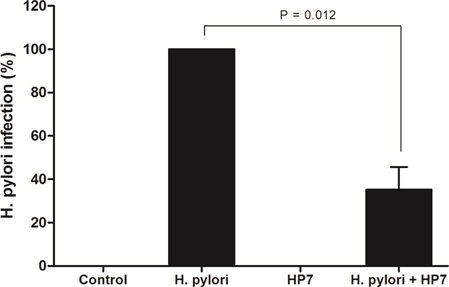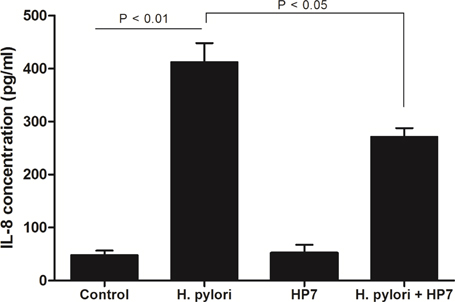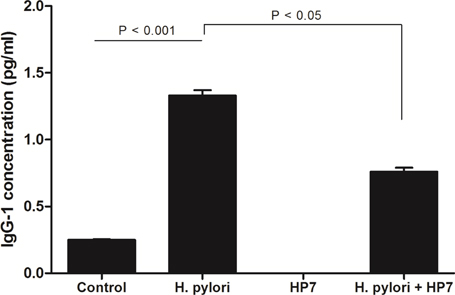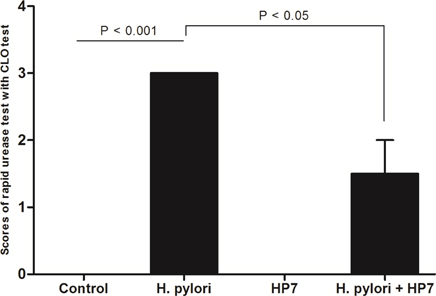Lab Anim Res.
2018 Dec;34(4):216-222. 10.5625/lar.2018.34.4.216.
In vitro and in vivo inhibition of Helicobacter pylori by Lactobacilllus paracasei HP7
- Affiliations
-
- 1Division of Gastroenterology, Vievisnamuh Hospital, Seoul, Korea.
- 2Center for Animal Resource Development, Wonkwang University, Iksan, Korea. kimoj@wku.ac.kr
- 3R & BD Center, Korea Yakult Co., Ltd., Yongin, Korea.
- 4Department of Companion Animal and Animal Resources Science, Joongbu University, Geumsan-gun, Korea.
- KMID: 2459298
- DOI: http://doi.org/10.5625/lar.2018.34.4.216
Abstract
- The efficacy of standard therapeutic strategies for Helicobacter pylori (H. pylori) infection is decreasing over time due to the emergence of drug-resistant strains. As an alternative, the present study investigated the capacity of Lactobacilllus paracasei (L. paracasei) HP7, isolated from kimchi, to inhibit H. pylori growth. The effects of L. paracasei HP7 on H. pylori adhesion and H. pylori-induced inflammation were examined in AGS human gastric adenocarcinoma epithelial cells and a mouse model of H. pylori SS1 infection. L. paracasei HP7 reduced H. pylori adhesion to AGS cells and suppressed the inflammatory response in infected cells by downregulating interleukin-8. H. pylori colonization in the stomach of C57BL/6 mice was demonstrated by rapid urease test, and results showed significant decrease in mice post-treated with L. paracasei HP7. Additionally, L. paracasei HP7 decreased gastric inflammation and epithelial lesions in the stomach of H. pylori-infected mice. These results demonstrate that L. paracasei HP7 treatment can inhibit H. pylori growth and is thus a promising treatment for patients with gastric symptoms such as gastritis that are caused by H. pylori infection.
Keyword
MeSH Terms
Figure
Reference
-
1. Blaser MJ. Helicobacter pylori and the pathogenesis of gastroduodenal inflammation. J Infect Dis. 1990; 161(4):626–633.2. Everhart JE. Recent developments in the epidemiology of Helicobacter pylori. Gastroenterol Clin North Am. 2000; 29(3):559–578.3. Sugiyama A, Maruta F, Ikeno T, Ishida K, Kawasaki S, Katsuyama T, Shimizu N, Tatematsu M. Helicobacter pylori infection enhances N-methyl-N-nitrosourea-induced stomach carcinogenesis in the Mongolian gerbil. Cancer Res. 1998; 58(10):2067–2069.4. Maruta F, Ota H, Genta RM, Sugiyama A, Tatematsu M, Katsuyama T, Kawasaki S. Role of N-methyl-N-nitrosourea in the induction of intestinal metaplasia and gastric adenocarcinoma in Mongolian gerbils infected with Helicobacter pylori. Scand J Gastroenterol. 2001; 36(3):283–290.5. Asaka M, Sugiyama T, Kato M, Satoh K, Kuwayama H, Fukuda Y, Fujioka T, Takemoto T, Kimura K, Shimoyama T, Shimizu K, Kobayashi S. A multicenter, double-blind study on triple therapy with lansoprazole, amoxicillin and clarithromycin for eradication of Helicobacter pylori in Japanese peptic ulcer patients. Helicobacter. 2001; 6(3):254–261.6. Salih BA, Abasiyanik MF, Saribasak H, Huten O, Sander E. A follow-up study on the effect of Helicobacter pylori eradication on the severity of gastric histology. Dig Dis Sci. 2005; 50(8):1517–1522.7. Maruta F, Sugiyama A, Ishizone S, Miyagawa S, Ota H, Katsuyama T. Eradication of Helicobacter pylori decreases mucosal alterations linked to gastric carcinogenesis in Mongolian gerbils. J Gastroenterol. 2005; 40(1):104–105.8. Misiewicz JJ, Harris AW, Bardhan KD, Levi S, O'Morain C, Cooper BT, Kerr GD, Dixon MF, Langworthy H, Piper D. One week triple therapy for Helicobacter pylori: a multicentre comparative study. Lansoprazole Helicobacter Study Group. Gut. 1997; 41(6):735–739.9. Malfertheiner P, Megraud F, O'Morain CA, Atherton J, Axon AT, Bazzoli F, Gensini GF, Gisbert JP, Graham DY, Rokkas T, El-Omar EM, Kuipers EJ. European Helicobacter Study Group. Management of Helicobacter pylori infection--the Maastricht IV/Florence Consensus Report. Gut. 2012; 61(5):646–664.10. Midolo PD, Lambert JR, Turnidge J. Metronidazole resistance: a predictor of failure of Helicobacter pylori eradication by triple therapy. J Gastroenterol Hepatol. 1996; 11(3):290–292.11. Graham DY, Fischbach L. Helicobacter pylori treatment in the era of increasing antibiotic resistance. Gut. 2010; 59(8):1143–1153.12. Megraud F, Coenen S, Versporten A, Kist M, Lopez-Brea M, Hirschl AM, Andersen LP, Goossens H, Glupczynski Y. Study Group participants. Helicobacter pylori resistance to antibiotics in Europe and its relationship to antibiotic consumption. Gut. 2013; 62(1):34–42.13. Buenz EJ, Bauer BA, Schnepple DJ, Wahner-Roedler DL, Vandell AG, Howe CL. A randomized Phase I study of Atuna racemosa: a potential new anti-MRSA natural product extract. J Ethnopharmacol. 2007; 114(3):371–376.14. Liu CS, Cham TM, Yang CH, Chang HW, Chen CH, Chuang LY. Antibacterial properties of Chinese herbal medicines against nosocomial antibiotic resistant strains of Pseudomonas aeruginosa in Taiwan. Am J Chin Med. 2007; 35(6):1047–1060.15. Franceschi F, Cazzato A, Nista EC, Scarpellini E, Roccarina D, Gigante G, Gasbarrini G, Gasbarrini A. Role of probiotics in patients with Helicobacter pylori infection. Helicobacter. 2007; 12:Suppl 2. 59–63.16. Kim MN, Kim N, Lee SH, Park YS, Hwang JH, Kim JW, Jeong SH, Lee DH, Kim JS, Jung HC, Song IS. The effects of probiotics on PPI-triple therapy for Helicobacter pylori eradication. Helicobacter. 2008; 13(4):261–268.17. Kabir AM, Aiba Y, Takagi A, Kamiya S, Miwa T, Koga Y. Prevention of Helicobacter pylori infection by lactobacilli in a gnotobiotic murine model. Gut. 1997; 41(1):49–55.18. Coconnier MH, Liévin V, Bernet-Camard MF, Hudault S, Servin AL. Antibacterial effect of the adhering human Lactobacillus acidophilus strain LB. Antimicrob Agents Chemother. 1997; 41(5):1046–1052.19. Coconnier MH, Lievin V, Hemery E, Servin AL. Antagonistic activity against Helicobacter infection in vitro and in vivo by the human Lactobacillus acidophilus strain LB. Appl Environ Microbiol. 1998; 64(11):4573–4580.20. Michetti P, Dorta G, Wiesel PH, Brassart D, Verdu E, Herranz M, Felley C, Porta N, Rouvet M, Blum AL, Corthésy-Theulaz I. Effect of whey-based culture supernatant of Lactobacillus acidophilus (johnsonii) La1 on Helicobacter pylori infection in humans. Digestion. 1999; 60(3):203–209.21. Liu H, Rahman A, Semino-Mora C, Doi SQ, Dubois A. Specific and sensitive detection of H. pylori in biological specimens by real-time RT-PCR and in situ hybridization. PLoS One. 2008; 3(7):e2689.22. Moon DI, Shin EH, Oh HG, Oh JS, Hong S, Chung Y, Kim O. Usefulness of a Helicobacter pylori stool antigen test for diagnosing H. pylori infected C57BL/6 mice. Lab Anim Res. 2013; 29(1):27–32.23. Lee HA, Hong S, Oh HG, Park SH, Kim YC, Park H, Jeong GS, Kim O. Antibacterial Activity of Sanguisorba officinalis against Helicobacter pylori. Lab Anim Res. 2010; 26(3):257–263.24. Lee HA, Hong S, Oh HG, Park SH, Kim YC, Jeong GS, Kim O. In vitro and in vivo Antibacterial Activities of Cinnamomum cassia Extracts Against Helicobacter pylori. Lab Anim Res. 2010; 26(1):21–29.25. Kreuning J, Lindeman J, Biemond I, Lamers CB. Relation between IgG and IgA antibody titres against Helicobacter pylori in serum and severity of gastritis in asymptomatic subjects. J Clin Pathol. 1994; 47(3):227–231.26. Vandenbergh PA. Lactic acid bacteria, their metabolic products and interference with microbial growth. FEMS Microbiol Rev. 1993; 12(1-3):221–237.
Article27. Rolfe RD. The role of probiotic cultures in the control of gastrointestinal health. J Nutr. 2000; 130:2S Suppl. 396S–402S.
Article28. Canducci F, Armuzzi A, Cremonini F, Cammarota G, Bartolozzi F, Pola P, Gasbarrini G, Gasbarrini A. A lyophilized and inactivated culture of Lactobacillus acidophilus increases Helicobacter pylori eradication rates. Aliment Pharmacol Ther. 2000; 14(12):1625–1629.29. Sgouras D, Maragkoudakis P, Petraki K, Martinez-Gonzalez B, Eriotou E, Michopoulos S, Kalantzopoulos G, Tsakalidou E, Mentis A. In vitro and in vivo inhibition of Helicobacter pylori by Lactobacillus casei strain Shirota. Appl Environ Microbiol. 2004; 70(1):518–526.30. Sgouras DN, Panayotopoulou EG, Martinez-Gonzalez B, Petraki K, Michopoulos S, Mentis A. Lactobacillus johnsonii La1 attenuates Helicobacter pylori-associated gastritis and reduces levels of proinflammatory chemokines in C57BL/6 mice. Clin Diagn Lab Immunol. 2005; 12(12):1378–1386.31. Lionetti E, Miniello VL, Castellaneta SP, Magistá AM, de Canio A, Maurogiovanni G, Ierardi E, Cavallo L, Francavilla R. Lactobacillus reuteri therapy to reduce side-effects during anti-Helicobacter pylori treatment in children: a randomized placebo controlled trial. Aliment Pharmacol Ther. 2006; 24(10):1461–1468.32. Ryan KA, Daly P, Li Y, Hooton C, O'Toole PW. Strain-specific inhibition of Helicobacter pylori by Lactobacillus salivarius and other lactobacilli. J Antimicrob Chemother. 2008; 61(4):831–834.33. Ki MR, Ghim SY, Hong IH, Park JK, Hong KS, Ji AR, Jeong KS. In vitro inhibition of Helicobacter pylori growth and of adherence of cagA-positive strains to gastric epithelial cells by Lactobacillus paraplantarum KNUC25 isolated from kimchi. J Med Food. 2010; 13(3):629–634.34. Sakamoto I, Igarashi M, Kimura K, Takagi A, Miwa T, Koga Y. Suppressive effect of Lactobacillus gasseri OLL 2716 (LG21) on Helicobacter pylori infection in humans. J Antimicrob Chemother. 2001; 47(5):709–710.35. Salas-Jara MJ, Sanhueza EA, Retamal-Díaz A, González C, Urrutia H, García A. Probiotic Lactobacillus fermentum UCO-979C biofilm formation on AGS and Caco-2 cells and Helicobacter pylori inhibition. Biofouling. 2016; 32(10):1245–1257.36. Song HY, Zhou L, Liu DY, Yao XJ, Li Y. What Roles Do Probiotics Play in the Eradication of Helicobacter pylori? Current Knowledge and Ongoing Research. Gastroenterol Res Pract. 2018; 2018:9379480.
- Full Text Links
- Actions
-
Cited
- CITED
-
- Close
- Share
- Similar articles
-
- Anti-Helicobacter pylori activity of acomplex mixture of Lactobacillus paracasei HP7 including the extract of Perilla frutescens var. acuta and Glycyrrhiza glabra
- Synergistic effect of probiotic HP7 and the extracts of Perilla frutescens and Glycyrrhiza glabra to alleviate Helicobacter pylori-induced damages
- In vitro and in vivo antibacterial activity of Meliae fructus extract against Helicobacter pylori
- The antibacterial effect of fatty acids on Helicobacter pylori infection
- Response to Treatment of Helicobacter pylori-associated Dyspepsia: Eradication of Helicobacter pylori or Correction of Gastric or Intestinal Dysbiosis?





